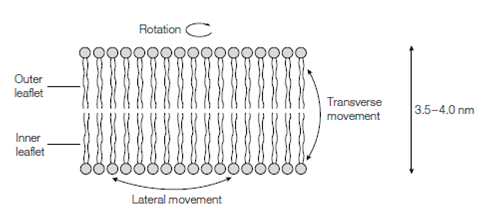Membrane fiuidity
Because there are no covalent bonds among the lipids in the bilayer the membrane has fiuidity but is not a static structure. The lipids are commonly free to move within the plane of the inner or outer leafiet of the bilayer through either lateral or rotational movement. Moreover, they cannot readily fiip from one leafiet of the bilayer to the other so-called transverse movement, due to the unfavorable energetics included in moving a hydrophilic headgroup by the hydrophobic interior of the bilayer. Fuidity of the bilayer can be altered in a number of ways. Ahead heating above a characteristic transition temperature, the lipid bilayer will modify from a gel-like consistency to a more fiuid-like consistency. That transition temperature depends on the length of the fatty acid chains and on their degree of unsaturation. If the length of the fatty acid chains is raise the fiuidity of the bilayer will decrease due to the bigger propensity for noncovalent interactions among the hydrocarbon chains. In difference, if the degree of unsaturation in the fatty acid chains is increased fiuidity of the bilayer will increase. This is just because the double bonds that are in the cis configuration kink the hydrocarbon disrupt and chain the highly ordered packing of the fatty acid chains, therefore reducing the number of interactions among neighboring lipids. A significant regulator of membrane fiuidity in mammalian systems is cholesterol. At physiological 37°C temperature, increasing the amount of cholesterol in the bilayer will lead to a decrease in the fiuidity of the membrane since the rigid steroid ring system interferes with the lateral movement of the fatty acid chains.

Figure: Movement of lipids in membranes